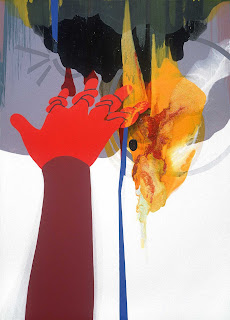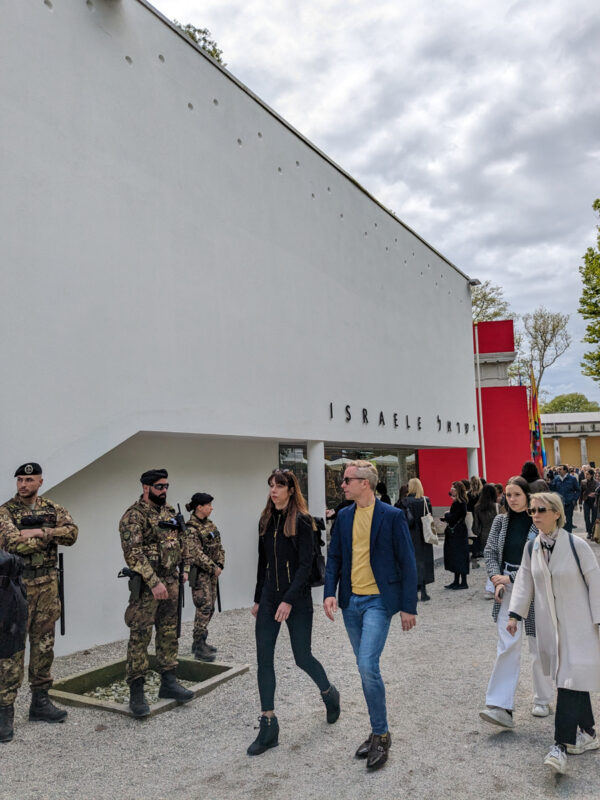 Carrie Moyer: Painting Propaganda by Alzaruba
Carrie Moyer: Painting Propaganda by Alzaruba
American University Museum at the Katzen Arts Center
Jan 24- March 15
Underlying the surge of identity politics in recent years, there’s been a rush towards staking out specific conceptual territory that’s too often resulted in glib work that may be more interesting as an idea than in its visual resonance. In many cases, these politically correct division lines often decry, dismiss or ignore a visual connectivity with anything greater than their own internal concerns.
Carrie Moyer’s potent exhibition at the Katzen Center in DC is a marvelous counterbalance to this trend. She makes visual resonance her platform for launching her concepts. Her powerful works, subliminally charged with sexual politics and gender issues, first hit the viewer with a refreshing intersection of art world bloodlines, which offers much to ponder to a greater range of viewers than her core ideas might initially suggest.
 She’s a meat and potatoes painter of arresting abstract/coded imagery and organic form. Looking at net images completely misses the startling surfaces of her poured and painted canvases- their seductive physicality and especially their reductive, often graphic dance between flat, satin and glossy contrasts. She knows how to snag the viewer from across a large space, and then deliver a close-up kiss and punch, as one begins to digest her abstracted imagery and processes. Mind you, I normally despise glitter. But here it finds a surprising counterbalance that doesn’t overstate its role. She also uses transparencies and color relationships on her spare backgrounds to evoke a charged atmosphere that is greater than the sum of its alchemical parts, such as Psychographic Landscape v.2.
She’s a meat and potatoes painter of arresting abstract/coded imagery and organic form. Looking at net images completely misses the startling surfaces of her poured and painted canvases- their seductive physicality and especially their reductive, often graphic dance between flat, satin and glossy contrasts. She knows how to snag the viewer from across a large space, and then deliver a close-up kiss and punch, as one begins to digest her abstracted imagery and processes. Mind you, I normally despise glitter. But here it finds a surprising counterbalance that doesn’t overstate its role. She also uses transparencies and color relationships on her spare backgrounds to evoke a charged atmosphere that is greater than the sum of its alchemical parts, such as Psychographic Landscape v.2.

This weave provokes a dichotomy of contrasts- yes, in one way it’s butch work- strongly assertive and to the point. There is a minimum of fuss, pared to the chase and the waiting trap. Yet these works also call, suggest, offer, pull, tickle and expand in ways that embraces a surprising plethora of associations, from the erotic to the cerebral to the universal. The show is well worth more than a single careful visit. The paintings linger in the eye, beyond Moyer’s bold proclamation:

Feminist Artist Statement
Known for paintings that merged the gestures of mid-century abstraction with the political iconography of 20th-century radical graphics, I continue my ongoing interrogation of Modernism with a significantly expanded visual lexicon. My recent paintings are inspired in part by the current critical reassessment of the Feminist Art Movement of the 1970s. Recalling my own first eye-opening encounter with feminist work as a young artist, the paintings are full of forms that resonate with the strangeness and preliterate opaqueness of archaic sculpture. Invented avatars — reminiscent of the Venus of Willendorf, ceremonial instruments, human beings and animals — are evoked through the interplay of abstract shapes, flows of pure color, glitter and transparent veils of poured acrylic. Tongue-in-cheek investigations of Herstory and Judy Chicago’s “central core” imagery are playfully tweaked in large paintings that place abstracted fertility symbols within flat, poster-like landscapes worthy of a 1960s Supergraphic. Employing a deepened sense of painterly call and response with puddles and flows of suggestive color, the “The Stone Age” paintings are as refined and elegant as a Kenneth Noland bulls-eye and as raw and bold as a primal scream.
While there also make a point to take in Paul Daniel’s beautifully presented, colorfully playful Kinetic Sculptures and the delightful WPA show!
http://www.american.edu/cas/katzen/museum/



